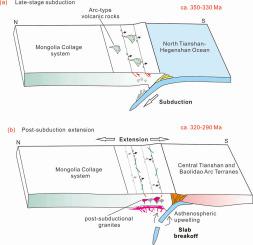当前位置:
X-MOL 学术
›
Gondwana Res.
›
论文详情
Our official English website, www.x-mol.net, welcomes your
feedback! (Note: you will need to create a separate account there.)
Magmatic evidence for late Carboniferous-early Permian slab breakoff and extension of the southern Mongolia collage system in Central Asia
Gondwana Research ( IF 7.2 ) Pub Date : 2021-01-01 , DOI: 10.1016/j.gr.2020.09.006 Hai Zhou , Guochun Zhao , Yigui Han , Donghai Zhang , Qian Zhao , Enkh-Orshikh Orsoo , Xianzhi Pei
Gondwana Research ( IF 7.2 ) Pub Date : 2021-01-01 , DOI: 10.1016/j.gr.2020.09.006 Hai Zhou , Guochun Zhao , Yigui Han , Donghai Zhang , Qian Zhao , Enkh-Orshikh Orsoo , Xianzhi Pei

|
Abstract Oceanic subduction and its last underthrusted part can both triggers arc-like magmatism. As the existence of multi-subduction zones in the Central Asian Orogenic Belt, controversy still surrounds on when and especially how the subduction of the (Paleo-Asian Ocean) PAO terminated. Here, we present geochronological, geochemical, and Lu Hf isotopic data for a suite of basalt-andesites, dacite-rhyolites and later trachyandesite-mugearitic dykes from the Khan Bogd area in the Gobi Tianshan Zone (GTZ) of the southern Mongolia. U Pb dating of zircons indicate the basalt-andesites and dacite-rhyolites were formed at ~334–338 Ma, and the dykes at ~300 Ma. These Early Carboniferous volcanic rocks display high U/Th, Ba/Th, low La/Sm and variable Zr/Nb ratios, implying the involvement of subduction fluids or sediment melt. They display arc geochemical features such as calc-alkaline and metaluminous nature and positive Ba and U and negative Nb, Ta and Ti anomalies. Moreover, their continental geochemical signals (e.g. positive Pb, K anomalies) and old captured zircons (~1.9–2.5 Ga, basalt sample MG19) implying a continental arc setting. Comparatively, the ~300 Ma dykes are characterized by high alkaline contents, which are common for coeval (~320–290 Ma) and widespread post-subductional granites there. Given a mainly crust-derived magma source for those granites, these dykes likely reflect a mantle disturbance due to: (1) their relative low SiO2 (51.71–55.85 wt%) and high Mg# (40.3–67.3) values, and (2) positive zircon ƐHf(t) (most >12). Considering a slab rollback model during the Carboniferous and Triassic, the mantle disturbance was possibly induced by the oceanic slab breakoff. Combined with previous work, this ~320–290 Ma slab breakoff-induced extension marks the closure of a wide secondary ocean (North Tianshan-Hegenshan ocean) north of the main ocean basin of the PAO.
中文翻译:

中亚蒙古南部拼贴系统晚石炭世-早二叠世板块断裂和延伸的岩浆证据
摘要 大洋俯冲及其最后一个未冲断的部分都可以引发弧状岩浆作用。由于中亚造山带存在多个俯冲带,(古亚洲洋)PAO的俯冲何时终止,特别是如何终止,仍存在争议。在这里,我们提供了一组来自蒙古南部戈壁天山带 (GTZ) 的汗博格德地区的玄武岩安山岩、英安岩流纹岩和后来的粗安岩岩脉的年代学、地球化学和 Lu Hf 同位素数据。锆石 U Pb 定年表明玄武岩安山岩和英安岩流纹岩形成于~334-338 Ma,岩脉形成于~300 Ma。这些早石炭世火山岩显示出高 U/Th、Ba/Th、低 La/Sm 和可变的 Zr/Nb 比率,这意味着俯冲流体或沉积物熔体的参与。它们显示出弧形地球化学特征,如钙碱性和金属铝质,Ba 和 U 为正,Nb、Ta 和 Ti 为负异常。此外,它们的大陆地球化学信号(例如正 Pb、K 异常)和古老的捕获锆石(~1.9-2.5 Ga,玄武岩样品 MG19)暗示大陆弧设置。相比之下,~300 Ma 岩脉的特点是碱性含量高,这对于同期(~320-290 Ma)和广泛的俯冲后花岗岩来说是常见的。考虑到这些花岗岩的主要来自地壳的岩浆源,这些岩脉可能反映了地幔扰动,原因是:(1) 它们相对较低的 SiO2 (51.71–55.85 wt%) 和高 Mg# (40.3–67.3) 值,以及 (2) ) 正锆石 ƐHf(t)(大多数 >12)。考虑石炭纪和三叠纪的板块回滚模型,地幔扰动可能是由大洋板块断裂引起的。结合先前的工作,这种~320-290 Ma 板块断裂引起的伸展标志着 PAO 主洋盆以北的广阔次生洋(北天山-和根山洋)的闭合。
更新日期:2021-01-01
中文翻译:

中亚蒙古南部拼贴系统晚石炭世-早二叠世板块断裂和延伸的岩浆证据
摘要 大洋俯冲及其最后一个未冲断的部分都可以引发弧状岩浆作用。由于中亚造山带存在多个俯冲带,(古亚洲洋)PAO的俯冲何时终止,特别是如何终止,仍存在争议。在这里,我们提供了一组来自蒙古南部戈壁天山带 (GTZ) 的汗博格德地区的玄武岩安山岩、英安岩流纹岩和后来的粗安岩岩脉的年代学、地球化学和 Lu Hf 同位素数据。锆石 U Pb 定年表明玄武岩安山岩和英安岩流纹岩形成于~334-338 Ma,岩脉形成于~300 Ma。这些早石炭世火山岩显示出高 U/Th、Ba/Th、低 La/Sm 和可变的 Zr/Nb 比率,这意味着俯冲流体或沉积物熔体的参与。它们显示出弧形地球化学特征,如钙碱性和金属铝质,Ba 和 U 为正,Nb、Ta 和 Ti 为负异常。此外,它们的大陆地球化学信号(例如正 Pb、K 异常)和古老的捕获锆石(~1.9-2.5 Ga,玄武岩样品 MG19)暗示大陆弧设置。相比之下,~300 Ma 岩脉的特点是碱性含量高,这对于同期(~320-290 Ma)和广泛的俯冲后花岗岩来说是常见的。考虑到这些花岗岩的主要来自地壳的岩浆源,这些岩脉可能反映了地幔扰动,原因是:(1) 它们相对较低的 SiO2 (51.71–55.85 wt%) 和高 Mg# (40.3–67.3) 值,以及 (2) ) 正锆石 ƐHf(t)(大多数 >12)。考虑石炭纪和三叠纪的板块回滚模型,地幔扰动可能是由大洋板块断裂引起的。结合先前的工作,这种~320-290 Ma 板块断裂引起的伸展标志着 PAO 主洋盆以北的广阔次生洋(北天山-和根山洋)的闭合。











































 京公网安备 11010802027423号
京公网安备 11010802027423号